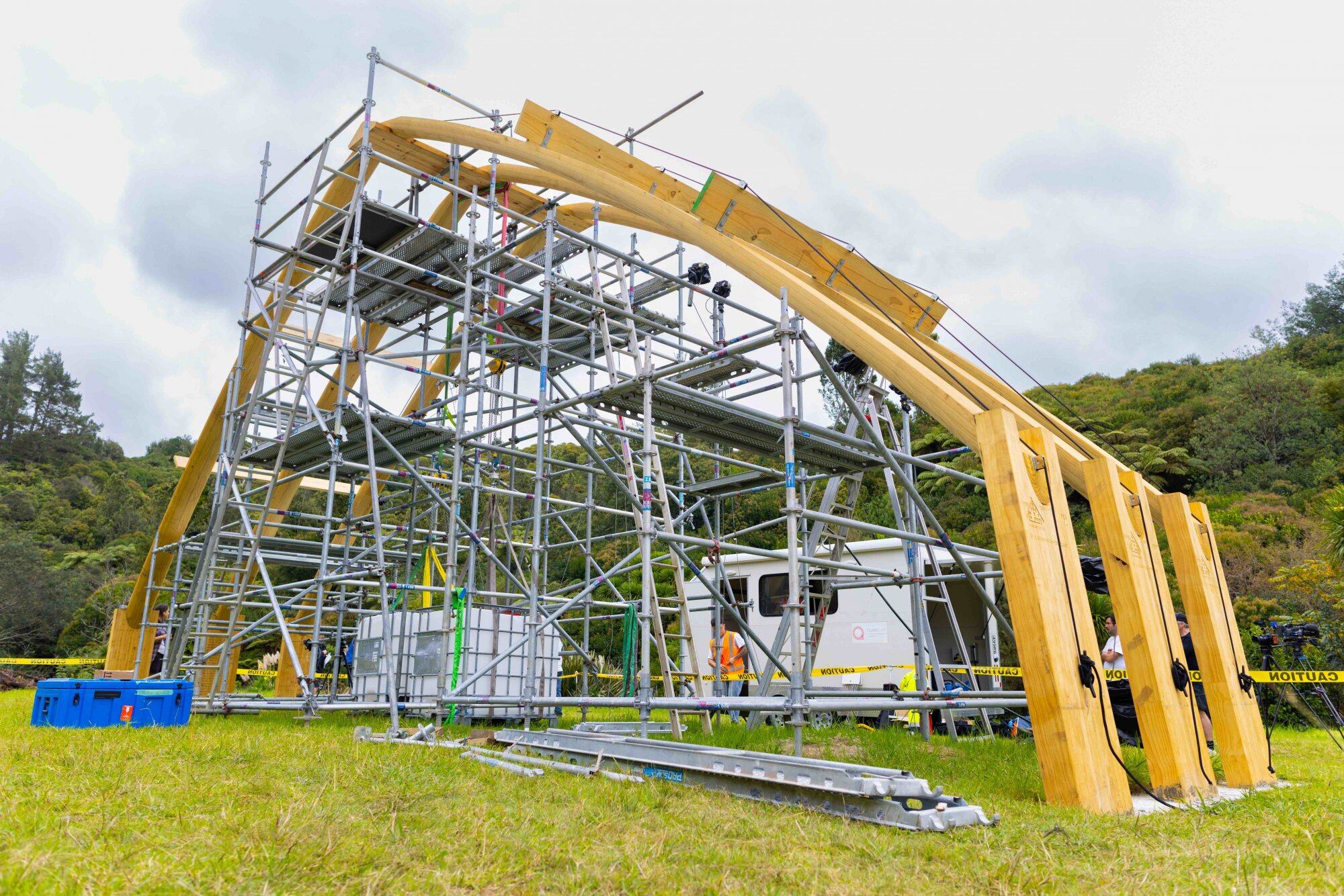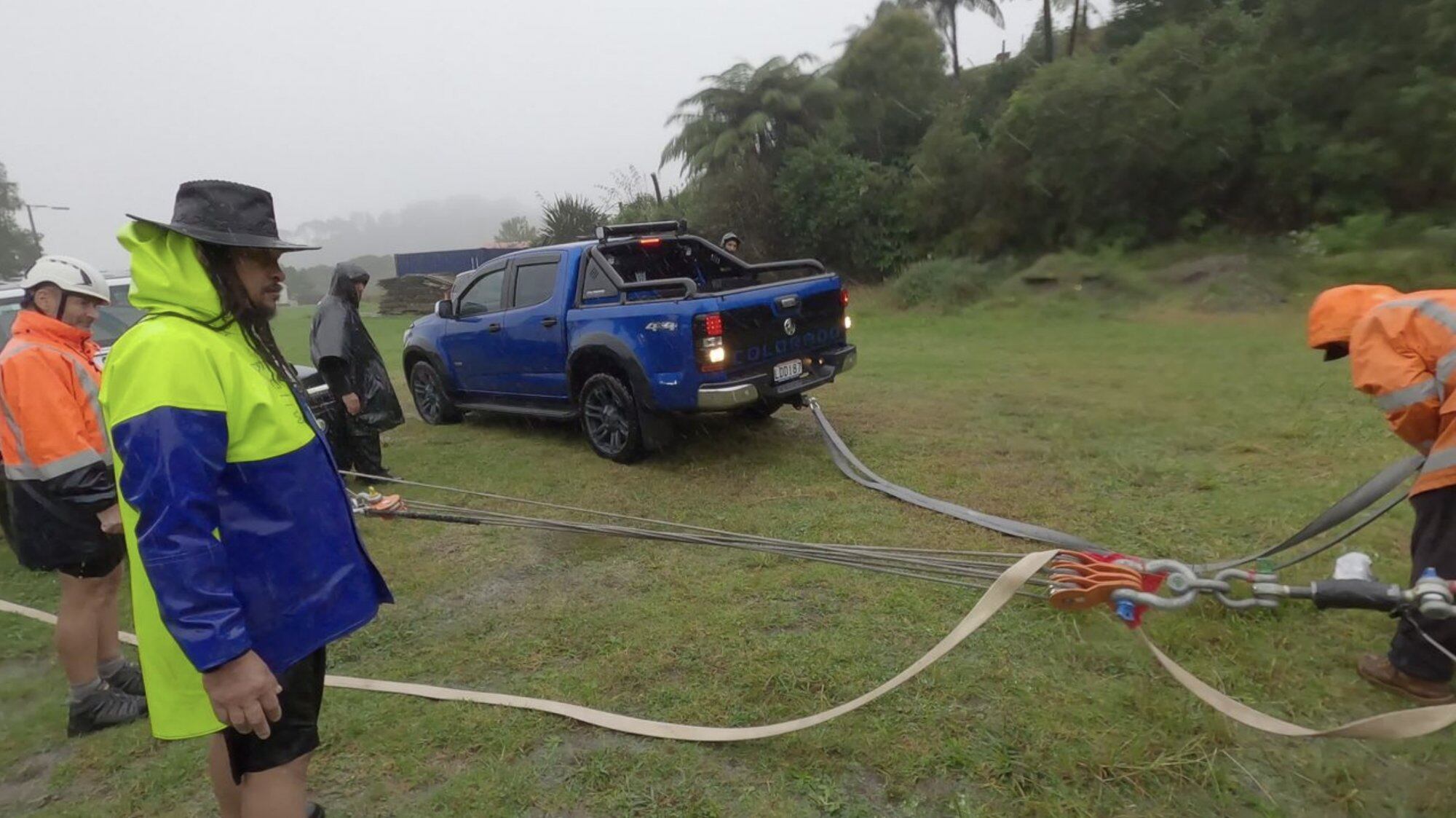Professor Anthony Hoete says seismic tests have demonstrated that the structure can withstand much stronger earthquakes than the 1931 Napier earthquake. Video / Supplied
Endangered Māori construction techniques have been "conclusively proven" to be capable of withstanding major earthquakes, Professor Anthony Hoete (Ngāti Awa, Ngāti Ranana) says, after his team successfully tested a full-scale timber structure in Ōpōtiki this weekend.
This knowledge will now be used to rebuild a historic Bay of Plenty wharenui, Tānewhirinaki.
Professor Hoete, an architect and researcher, along with a team from the University of Auckland used endangered construction knowledge called mīmiro to create a full-scale timber structure and successfully tested the prototype against earthquake requirements for modern buildings.
“In fact, our seismic tests have demonstrated the structure can withstand much stronger earthquakes than the one that caused critical damage to the original wharenui in the Napier earthquake in 1931,” an elated Professor Hoete said Sunday, through a media release issued by Toka Tū Ake EQC, the Earthquake Commission.

Professor Anthony Hoete explains the testing. Photo / supplied
Timber portals were designed and built using interlocking compression joints, instead of bolting parts together. At the same time, ropes were used to pull the structure to the ground like a tent.
During this past weekend, Professor Hoete’s team collaborated with the School of Engineering to pull the vertical portals sideways and test the horizontal strength of the structure, using a winch off a jeep, while the vertical strength was tested using water weights.

The prototype for the new whare before the testing. Photo / Supplied
Professor Hoete says the origins of mīmiro can be traced back to the vessels and strong sail lashing tūpuna used to travel across the Pacific.
“They had a deep knowledge of building and creating strength and tension in structures, so we have recreated those techniques that have been lost and use them to give our wharenui greater seismic resilience,” said Professor Hoete, who used modern sailing ropes and grinders to create the tension on the timber structure.

The grinders used to create tension on the timber structure. Photo / Supplied
The team has been working closely with Ngāti lra o Waioweka, who built the original Tānewhirinaki wharenui near Opōtiki after the 1860 New Zealand Wars, only to witness its destruction in the 7.8 magnitude earthquake in 1931.
The most important carvings representing their tūpuna were saved from the wreckage and remarkably stored in a shed at the marae for nine decades.
Professor Hoete says that the original timber had deteriorated over 90 years and would not be able to carry the loading of a new wharenui.
“So instead, we will design a new structure that will act like an outer whare to which we will sensitively attach the original carvings to the inside of this new structure.”

Trucks used to create the effect of an earthquake on the structure. Photo / Supplied
Local hapū, Ngāti Ira, is integral to the project and many local community members assisted in the construction and testing this week.
“The original house was built in 1874, and the inter-locking system at the time was unique compared to any other house in Aotearoa,” says Riki Kurei, the restoration project leader for the hapū.
“The ultimate goal for us is to have it standing again in three to five years. That was the dream of our kaumātua since it was pulled down and we will make it a reality for our hapū.”
Kurei says the hapū are actively looking for sponsors and support for the restoration and restanding of the historic wharenui.
The project team has involved the entire hapū in the project, through outreach events with local schools and the community, says Professor Hoete, who feels the learnings from this project have the "power to transform communities".
Toka Tū Ake EQC has provided funding to enhance the seismic resilience of the new wharenui.
“Toka Tū Ake EQC wants to create more resilient communities through the design and construction of stronger buildings, so Professor Hoete’s work aligns well with our goal to improve Aotearoa New Zealand’s resilience to natural hazards,” says Dr Jo Horrocks, Toka Tū Ake EQC's chief resilience and research officer.
“Investing in Māori researchers and matauranga Maōri has been a key focus of this year’s biennial grants, so we are proud to be able to support this amazing project.”
The research undertaken by Professor Hoete’s team has also been supported by QuakeCoRE, the Centre of Research Excellence for seismic resilience, and the Endangered Wooden Architecture Programme at Oxford Brookes University.
